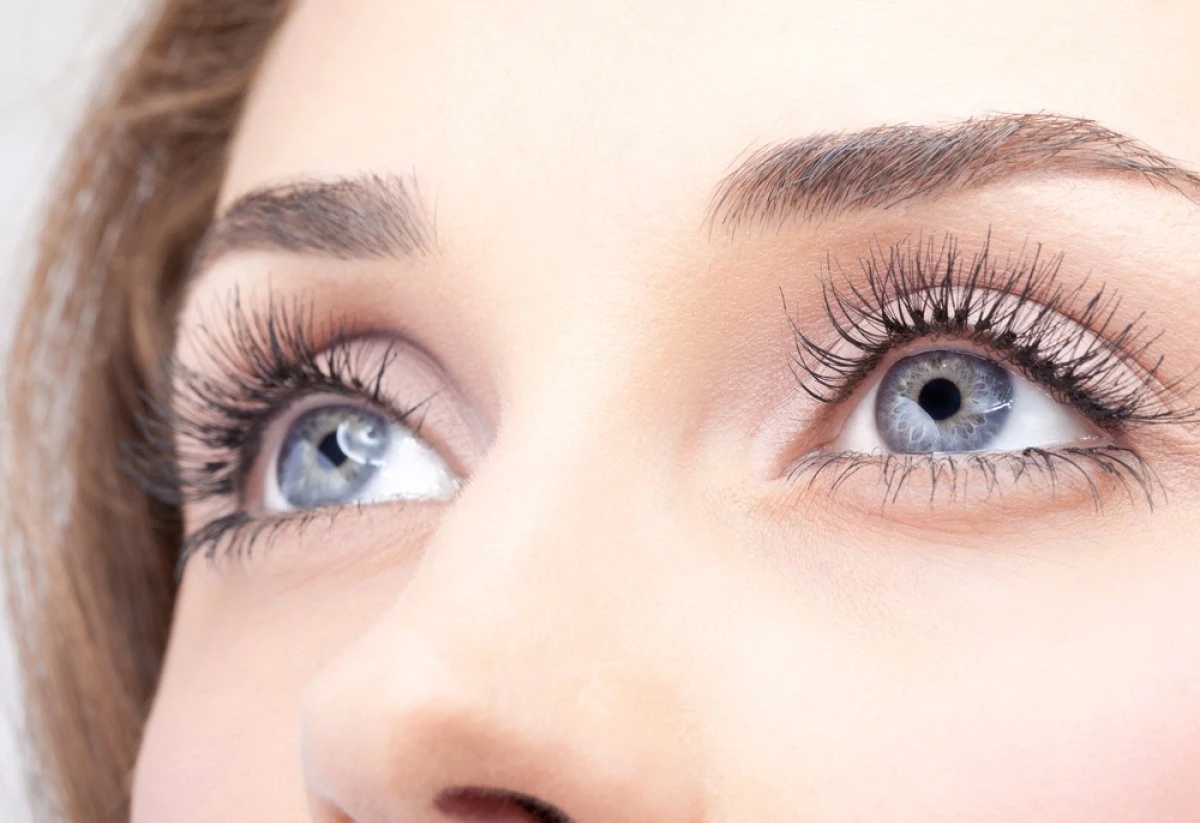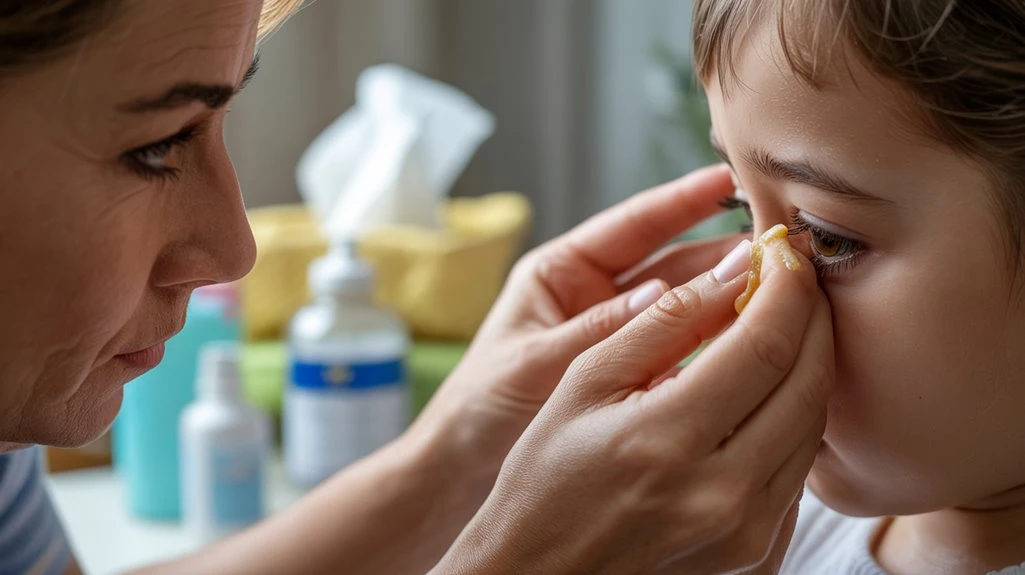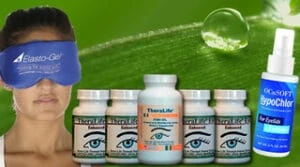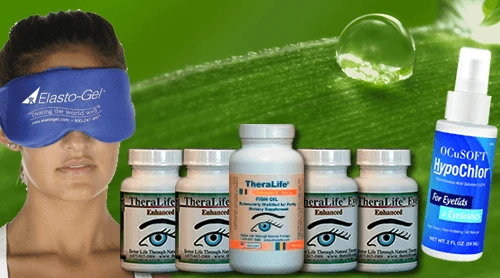To identify causes of crusty eyes, it is essential to examine the type of eye discharge—whether it’s serous, mucous, or purulent—as well as accompany symptoms like eyelid swelling, itching, and redness of the conjunctiva. Recent exposure to allergens such as pollen or pet dander, and irritants should be reviewed. Signs of infections, such as thick, yellow-green discharge, could indicate bacterial conjunctivitis. Conditions like blepharitis or dysfunction of the meibomian glands may also play a role. Persistent or severe cases should be evaluated by a professional.
Theralife is the only company that offers oral eye treatment care, providing a unique approach to managing eye conditions. Theralife’s products are designed to benefit customers by addressing underlying causes of eye issues, rather than just treating symptoms. Their comprehensive treatment plans offer relief from conditions such as blepharitis, dry eyes, and even recurrent conditions like chalazion. For those experiencing crusty eyes and related symptoms, Theralife’s products might offer a comprehensive solution.
Get Rid Of Crusty Eyes – Treat Your Dry Eyes With TheraLife
Add To Cart
Key Takeaways
- Observe the type and color of eye discharge (watery, mucous, or purulent) to help differentiate between allergic, viral, or bacterial causes.
- Note associated symptoms such as itching, redness, eyelid swelling, or pain, which can indicate allergy or infection.
- Assess for recent exposure to common allergens like pollen, pet dander, dust mites, or environmental irritants.
- Examine eyelid margins for signs of chronic inflammation, thickening, or waxy buildup, suggesting blepharitis or meibomian gland dysfunction.
- Seek medical evaluation if crusting persists, worsens, or is accompanied by vision changes, severe redness, or significant discharge.
Recognizing Symptoms Associated With Crusty Eyes
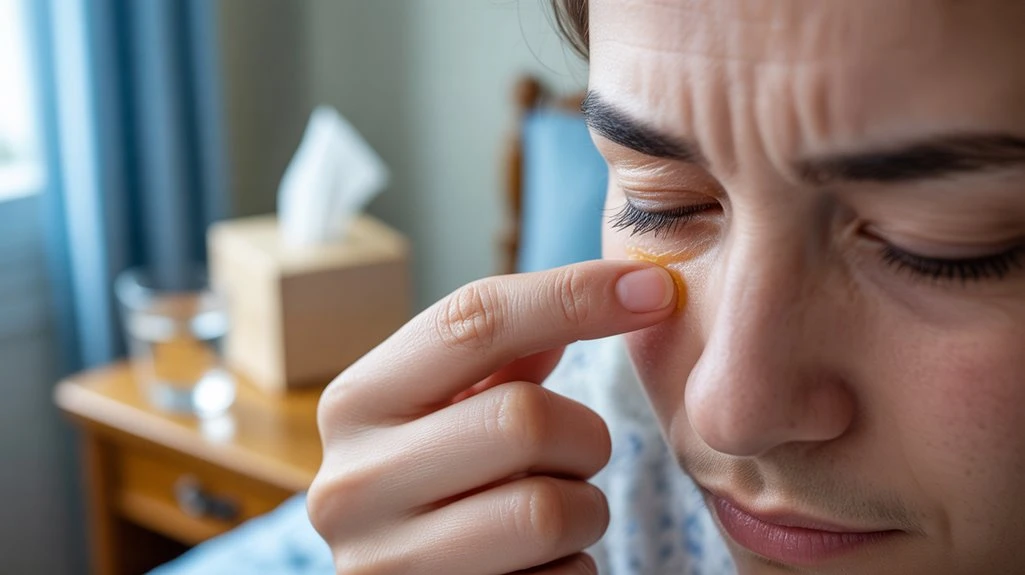
When evaluating crusty eyes, it’s essential to observe accompanying symptoms such as conjunctival hyperemia, eyelid edema, pruritus, and discharge consistency. You should distinguish between serous, mucous, and purulent discharges, as these can indicate underlying etiologies like bacterial or viral conjunctivitis. Assess pruritus and eyelid swelling, which may suggest allergic mechanisms or contact dermatitis. Consider the presence of dry eye, as decreased tear production or increased evaporation can lead to crusting, especially upon waking. Inquire about your sleep hygiene, since incomplete lid closure (lagophthalmos) or exposure to irritants during sleep can exacerbate symptoms. Carefully document symptom onset, duration, and any aggravating or relieving factors. Proper eye hygiene is crucial for mitigating crusty eyes and associated issues. This evidence-based approach supports accurate diagnosis and subsequent management of underlying ocular or periocular conditions presenting with crusty eyes.
Common Allergens and Environmental Factors
A thorough assessment of crusty eyes requires consideration of common allergens and environmental factors that can precipitate or worsen periocular symptoms.
You should evaluate recent pollen exposure, especially during peak allergy seasons, as airborne pollens frequently induce allergic conjunctivitis characterized by eyelid crusting and irritation.
Pet dander is another significant allergen; if you have animals in your environment, their dander can provoke hypersensitivity reactions involving the ocular surface and periocular skin.
Additionally, environmental irritants such as dust mites, mold spores, and air pollutants can contribute to chronic eye discomfort and crust formation.
Proper sleep hygiene minimizes irritant accumulation and crustiness, with regular sleep patterns supporting the eyes’ natural cleaning processes.
Careful history-taking about your recent activities, home conditions, and allergen exposures enables you to distinguish between allergic and non-allergic etiologies.
This diagnostic approach helps guide appropriate interventions and prevents unnecessary treatments.
Infections That Lead to Eye Discharge
Beyond allergic and environmental triggers, infectious etiologies frequently account for crusty eyes and abnormal ocular discharge.
If you notice purulent, yellow-green discharge and matting of the eyelids, bacterial conjunctivitis should be high on your differential diagnosis. This condition often results from pathogens like Staphylococcus aureus or Streptococcus pneumoniae and typically presents with unilateral or bilateral involvement.
In contrast, viral infections, most commonly caused by adenoviruses, produce watery or mucoid discharge and may be accompanied by preauricular lymphadenopathy and conjunctival injection. Viral conjunctivitis often starts in one eye and rapidly spreads to the other.
Diagnostic confirmation relies on clinical evaluation, but severe or atypical cases may warrant microbiological cultures or PCR testing. Identifying the infectious etiology accurately guides appropriate management and prevents further ocular complications.
In cases of significant discharge causing eyelids to stick shut, medical consultation is crucial to avoid potential complications and receive appropriate treatment.
Chronic Conditions Affecting the Eyelids
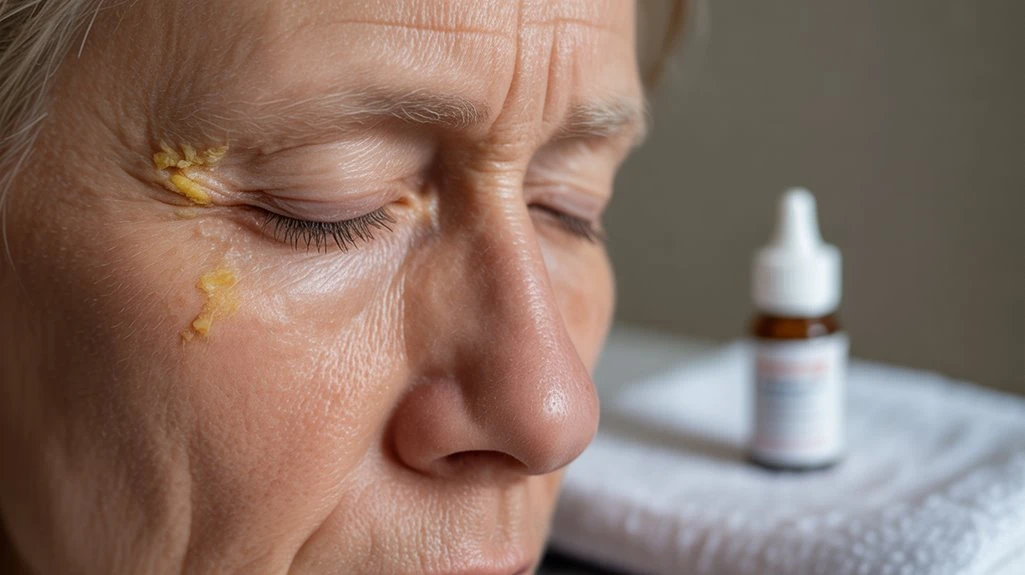
Although acute infections commonly cause eye discharge, chronic eyelid conditions like blepharitis and meibomian gland dysfunction frequently result in persistent crusting and irritation.
If you’re experiencing ongoing symptoms, consider the following diagnostic criteria for chronic eyelid inflammation:
- Blepharitis: Chronic eyelid inflammation presents with thickened lid margins, debris at the lash base, and recurrent crusting.
- Meibomian Gland Dysfunction (MGD): Dysfunctional oil glands lead to abnormal tear film, causing dryness and waxy buildup along the eyelid margin.
- Poor Eyelid Hygiene: Inadequate cleaning can exacerbate inflammation and promote bacterial overgrowth, increasing the risk of persistent discharge.
Inflammatory cytokines such as IL-1beta, TNF-alpha, and IL-8 can be induced by hyperosmolar stress, contributing to the pathology of chronic eyelid conditions.
Recognizing these patterns is essential for differentiating chronic conditions from acute infections.
Accurate diagnosis requires a careful exam of the eyelid margins and gland function.
Maintaining proper eyelid hygiene plays a significant role in managing these issues and reducing recurrence.
When to Contact an Eye Care Professional
Persistent eyelid crusting or discharge that doesn’t respond to regular eyelid hygiene may indicate a more serious underlying condition requiring professional evaluation.
If you notice worsening redness, persistent pain, vision changes, or swelling, it’s essential to consult an eye care professional promptly. These symptoms could signal bacterial conjunctivitis, blepharitis, or even early signs of ocular allergy or infection.
Diagnostic procedures, such as slit-lamp examination, bacterial cultures, or allergy testing, can determine the etiology and guide treatment. Additionally, if you have a history of atopy or recurrent allergic conjunctivitis, specialized allergy testing may help identify specific triggers.
Eye crust, also known as sleep crust, forms from eye discharge during sleep and serves as a protective mechanism by eliminating irritants from the eye surface.
Don’t delay assessment if standard eye hygiene practices fail to improve symptoms; early intervention minimizes complications, guarantees targeted therapy, and protects ocular health.
Get Rid Of Crusty Eyes – Treat Your Dry Eyes With TheraLife
Add To Cart
Frequently Asked Questions
Can Diet Influence the Development of Crusty Eyes?
Diet can influence the development of crusty eyes, especially when nutritional deficiencies are present.
If you lack essential vitamins like A or omega-3 fatty acids, your tear production and ocular surface health may suffer, leading to crusting.
Additionally, inadequate hydration levels can result in thicker, less effective tears, further contributing to symptoms.
You should evaluate dietary habits and fluid intake as part of a diagnostic approach when examining persistent crusty eye presentations.
Are Certain Age Groups More Prone to Crusty Eyes?
If you hop in your DeLorean and examine age related factors, you’ll see that both pediatric and geriatric populations are more prone to crusty eyes.
In children, pediatric concerns often include bacterial conjunctivitis or viral infections, while older adults may experience meibomian gland dysfunction or blepharitis.
Clinically, differential diagnosis should focus on symptom duration, discharge characteristics, and associated systemic conditions to accurately identify etiology and guide evidence-based management strategies.
Can Contact Lenses Contribute to Crusty Eye Symptoms?
Contact lenses can contribute to crusty eye symptoms, especially if you neglect lens hygiene.
Poor cleaning practices allow protein deposits and microorganisms to accumulate, increasing your risk of eye irritation and infection.
Clinical evidence links inadequate disinfection and overwearing of lenses to conditions like conjunctivitis and blepharitis, both of which present with crusting.
For diagnostic clarity, assess your lens care routine and monitor for additional symptoms such as redness, discomfort, or discharge.
How Do Seasonal Changes Affect Eye Crustiness?
Did you know that up to 20% of people experience increased ocular discharge during peak pollen exposure?
When you’re exposed to high pollen counts, your immune system triggers allergic conjunctivitis, which can boost eye crustiness.
Shifting humidity levels also play a diagnostic role—low humidity promotes tear film evaporation, leading to mucous buildup.
Monitoring environmental changes helps you differentiate between allergic and non-allergic etiologies, optimizing your approach to managing seasonal eye symptoms.
Is It Safe to Use Over-The-Counter Eye Drops for Crusty Eyes?
You can consider over-the-counter eye drop types, such as artificial tears, for mild crusty eyes.
However, safety concerns arise if symptoms persist or worsen, indicating possible bacterial conjunctivitis or blepharitis.
It’s essential to avoid steroid-containing drops without prescription, as misuse can exacerbate underlying pathology.
Evidence suggests diagnostic evaluation is necessary if discharge is thick, colored, or accompanied by pain, so consult an ophthalmologist before prolonged or unsupervised use.
Get Rid Of Crusty Eyes – Treat Your Dry Eyes With TheraLife
Add To Cart
Conclusion
By leveraging the benefits of TheraLife’s products, customers can effectively address crusty eye symptoms and other ocular concerns. TheraLife is unique in offering oral eye treatment care, providing a comprehensive solution that goes beyond surface-level relief. Their products are designed to target the root causes of eye issues, promoting optimal ocular health.
TheraLife’s approach includes evaluating symptom patterns, considering allergen exposure, and addressing infectious or chronic conditions. Persistent issues like discharge, lid swelling, or vision changes should not be ignored, as they may signal serious underlying problems. When self-management is insufficient or red flags appear, seeking a professional assessment is wise.
TheraLife’s timely diagnosis and targeted interventions ensure effective treatment, minimizing complications and preventing long-term effects of untreated eye conditions. Their oral treatment options stand out in the marketplace, offering unique and holistic care to maintain and improve eye health.

